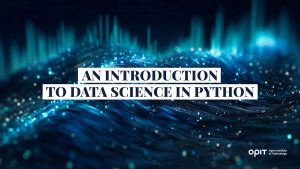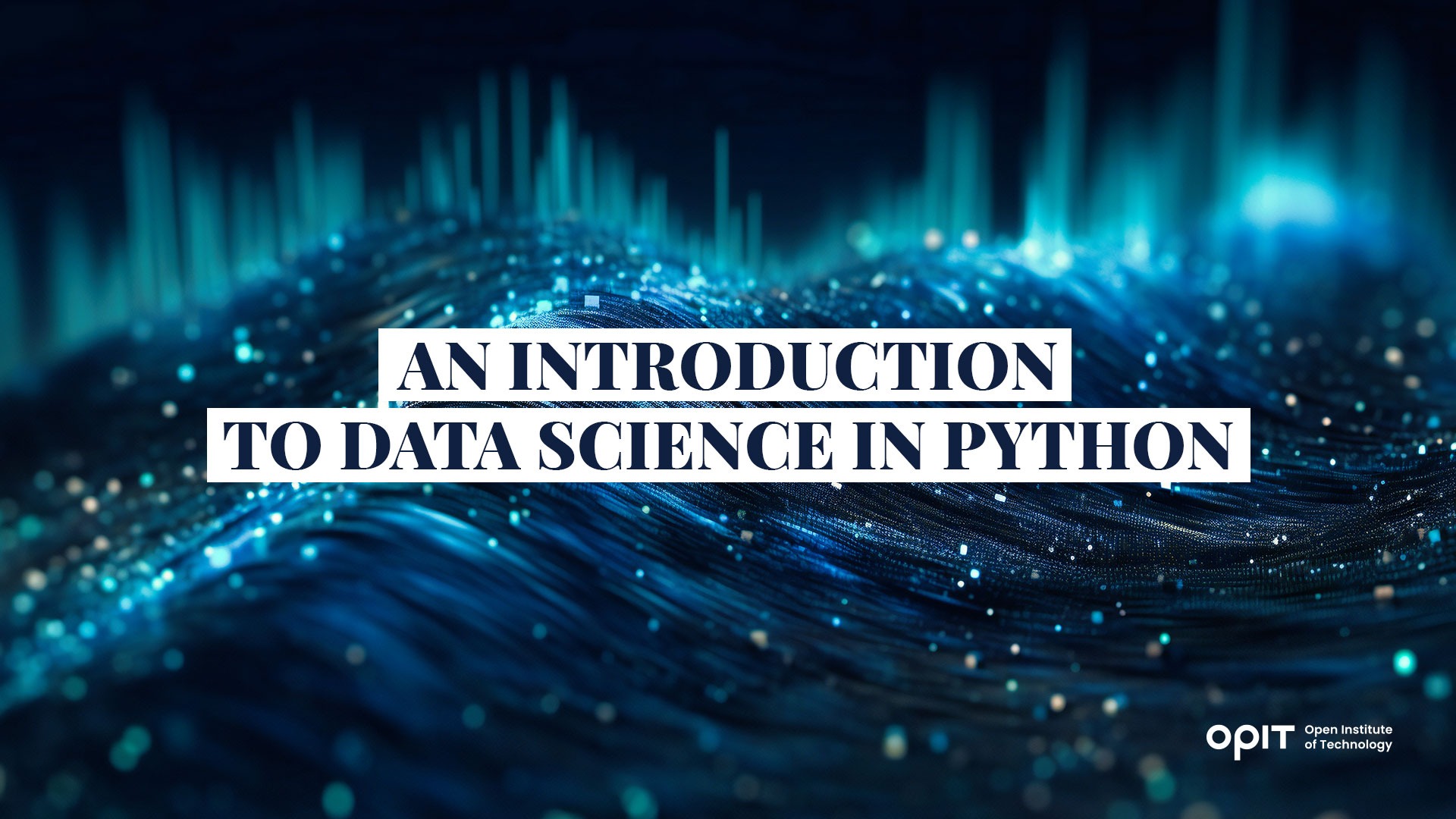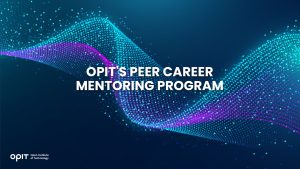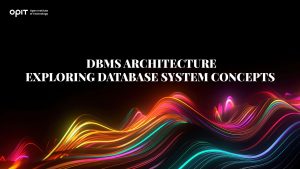

As one of the world’s fastest-growing industries, with a predicted compound annual growth rate of 16.43% anticipated between 2022 and 2030, data science is the ideal choice for your career. Jobs will be plentiful. Opportunities for career advancement will come thick and fast. And even at the most junior level, you’ll enjoy a salary that comfortably sits in the mid-five figures.
Studying for a career in this field involves learning the basics (and then the complexities) of programming languages including C+, Java, and Python. The latter is particularly important, both due to its popularity among programmers and the versatility that Python brings to the table. Here, we explore the importance of Python for data science and how you’re likely to use it in the real world.
Why Python for Data Science?
We can distill the reasons for learning Python for data science into the following five benefits.
Popularity and Community Support
Statista’s survey of the most widely-used programming languages in 2022 tells us that 48.07% of programmers use Python to some degree. Leftronic digs deeper into those numbers, telling us that there are 8.2 million Python developers in the world. As a prospective developer yourself, these numbers tell you two things – Python is in demand and there’s a huge community of fellow developers who can support you as you build your skills.
Easy to Learn and Use
You can think of Python as a primer for almost any other programming language, as it takes the fundamental concepts of programming and turns them into something practical. Getting to grips with concepts like functions and variables is simpler in Python than in many other languages. Python eventually opens up from its simplistic use cases to demonstrate enough complexity for use in many areas of data science.
Extensive Libraries and Tools
Given that Python was first introduced in 1991, it has over 30 years of support behind it. That, combined with its continued popularity, means that novice programmers can access a huge number of tools and libraries for their work. Libraries are especially important, as they act like repositories of functions and modules that save time by allowing you to benefit from other people’s work.
Integration With Other Programming Languages
The entire script for Python is written in C, meaning support for C is built into the language. While that enables easy integration between these particular languages, solutions exist to link Python with the likes of C++ and Java, with Python often being capable of serving as the “glue” that binds different languages together.
Versatility and Flexibility
If you can think it, you can usually do it in Python. Its clever modular structure, which allows you to define functions, modules, and entire scripts in different files to call as needed, makes Python one of the most flexible programming languages around.
Setting Up Python for Data Science
Installing Python onto your system of choice is simple enough. You can download the language from the Python.org website, with options available for everything from major operating systems (Windows, macOS, and Linux) to more obscure devices.
However, you need an integrated development environment (IDE) installed to start coding in Python. The following are three IDEs that are popular with those who use Python for data science:
- Jupyter Notebook – As a web-based application, Jupyter easily allows you to code, configure your workflows, and even access various libraries that can enhance your Python code. Think of it like a one-stop shop for your Python needs, with extensions being available to extend its functionality. It’s also free, which is never a bad thing.
- PyCharm – Where Jupyter is an open-source IDE for several languages, PyCharm is for Python only. Beyond serving as a coding tool, it offers automated code checking and completion, allowing you to quickly catch errors and write common code.
- Visual Studio Code – Though Visual Studio Code alone isn’t compatible with Python, it has an extension that allows you to edit Python code on any operating system. Its “Linting” feature is great for catching errors in your code, and it comes with an integrated debugger that allows you to test executables without physically running them.
Setting up your Python virtual environment is as simple as downloading and installing Python itself, and then choosing an IDE in which to work. Think of Python as the materials you use to build a house, with your IDE being both the blueprint and the tools you’ll need to patch those materials together.
Essential Python Libraries for Data Science
Just as you’ll go to a real-world library to check out books, you can use Python libraries to “check out” code that you can use in your own programs. It’s actually better than that because you don’t need to return libraries when you’re done with them. You get to keep them, along with all of their built-in modules and functions, to call upon whenever you need them. In Python for data science, the following are some essential libraries:
- NumPy – We spoke about integration earlier, and NumPy is ideal for that. It brings concepts of functionality from Fortran and C into Python. By expanding Python with powerful array and numerical computing tools, it helps transform it into a data science powerhouse.
- pandas – Manipulating and analyzing data lies at the heart of data sciences, and pandas give you a library full of tools to allow both. It offers modules for cleaning data, plotting, finding correlations, and simply reading CSV and JSON files.
- Matplotlib – Some people can look at reams of data and see patterns form within the numbers. Others need visualization tools, which is where Matplotlib excels. It helps you create interactive visual representations of your data for use in presentations or if you simply prefer to “see” your data rather than read it.
- Scikit-learn – The emerging (some would say “exploding) field of machine learning is critical to the AI-driven future we’re seemingly heading toward. Scikit-learn is a library that offers tools for predictive data analysis, built on what’s available in the NumPy and Matplotlib libraries.
- TensorFlow and Keras – Much like Scikit-learn, both TensorFlow and Keras offer rich libraries of tools related to machine learning. They’re essential if your data science projects take you into the realms of neural networks and deep learning.
Data Science Workflow in Python
A Python programmer without a workflow is like a ship’s captain without a compass. You can sail blindly onward, and you may even get lucky and reach your destination, but the odds are you’re going to get lost in the vastness of the programming sea. For those who want to use Python for data science, the following workflow brings structure and direction to your efforts.
Step 1 – Data Collection and Preprocessing
You need to collect, organize, and import your data into Python (as well as clean it) before you can draw any conclusions from it. That’s why the first step in any data science workflow is to prepare the data for use (hint – the pandas library is perfect for this task).
Step 2 – Exploratory Data Analysis (EDA)
Just because you have clean data, that doesn’t mean you’re ready to investigate what that data tells you. It’s like washing ingredients before you make a dish – you need to have a “recipe” that tells you how to put everything together. Data scientists use EDA as this recipe, allowing them to combine data visualization (remember – the Matplotlib library) with descriptive statistics that show them what they’re looking at.
Step 3 – Feature Engineering
This is where you dig into the “whats” and “hows” of your Python program. You’ll select features for the code, which define what it does with the data you import and how it’ll deliver outcomes. Scaling is a key part of this process, with scope creep (i.e., constantly adding features as you get deeper into a project) being the key thing to avoid.
Step 4 – Model Selection and Training
Decision trees, linear regression, logistic regression, neural networks, and support vector machines. These are all models (with their own algorithms) you can use for your data science project. This step is all about selecting the right model for the job (your intended features are important here) and training that model so it produces accurate outputs.
Step 5 – Model Evaluation and Optimization
Like a puppy that hasn’t been house trained, an unevaluated model isn’t ready for release into the real world. Classification metrics, such as a confusion matrix and classification report, help you to evaluate your model’s predictions against real-world results. You also need to tune the hyperparameters built into your model, similar to how a mechanic may tune the nuts and bolts in a car, to get everything working as efficiently as possible.
Step 6 – Deployment and Maintenance
You’ve officially deployed your Python for data science model when you release it into the wild and let it start predicting outcomes. But the work doesn’t end at deployment, as constant monitoring of what your model does, outputs, and predicts is needed to tell you if you need to make tweaks or if the model is going off the rails.
Real-World Data Science Projects in Python
There are many examples of Python for data science in the real world, some of which are simple while others delve into some pretty complex datasets. For instance, you can use a simple Python program to scrap live stock prices from a source like Yahoo! Finance, allowing you to create a virtual ticker of stock price changes for investors.
Alternatively, why not create a chatbot that uses natural language processing to classify and respond to text? For that project, you’ll tokenize sentences, essentially breaking them down into constituent words called “tokens,” and tag those tokens with meanings that you could use to prompt your program toward specific responses.
There are plenty of ideas to play around with, and Python is versatile enough to enable most, so consider what you’d like to do with your program and then go on the hunt for datasets. Great (and free) resources include The Boston House Price Dataset, ImageNet, and IMDB’s movie review database.
Try Python for Data Science Projects
By combining its own versatility with integrations and an ease of use that makes it welcoming to beginners, Python has become one of the world’s most popular programming languages. In this introduction to data science in Python, you’ve discovered some of the libraries that can help you to apply Python for data science. Plus, you have a workflow that lends structure to your efforts, as well as some ideas for projects to try. Experiment, play, and tweak models. Every minute you spend applying Python to data science is a minute spent learning a popular programming language in the context of a rapidly-growing industry.
Related posts

Source:
- Raconteur, published on November 06th, 2025
Many firms have conducted successful Artificial Intelligence (AI) pilot projects, but scaling them across departments and workflows remains a challenge. Inference costs, data silos, talent gaps and poor alignment with business strategy are just some of the issues that leave organisations trapped in pilot purgatory. This inability to scale successful experiments means AI’s potential for improving enterprise efficiency, decision-making and innovation isn’t fully realised. So what’s the solution?
Although it’s not a magic bullet, an AI operating model is really the foundation for scaling pilot projects up to enterprise-wide deployments. Essentially it’s a structured framework that defines how the organisation develops, deploys and governs AI. By bringing together infrastructure, data, people, and governance in a flexible and secure way, it ensures that AI delivers value at scale while remaining ethical and compliant.
“A successful AI proof-of-concept is like building a single race car that can go fast,” says Professor Yu Xiong, chair of business analytics at the UK-based Surrey Business School. “An efficient AI technology operations model, however, is the entire system – the processes, tools, and team structures – for continuously manufacturing, maintaining, and safely operating an entire fleet of cars.”
But while the importance of this framework is clear, how should enterprises establish and embed it?
“It begins with a clear strategy that defines objectives, desired outcomes, and measurable success criteria, such as model performance, bias detection, and regulatory compliance metrics,” says Professor Azadeh Haratiannezhadi, co-founder of generative AI company Taktify and professor of generative AI in cybersecurity at OPIT – the Open Institute of Technology.
Platforms, tools and MLOps pipelines that enable models to be deployed, monitored and scaled in a safe and efficient way are also essential in practical terms.
“Tools and infrastructure must also be selected with transparency, cost, and governance in mind,” says Efrain Ruh, continental chief technology officer for Europe at Digitate. “Crucially, organisations need to continuously monitor the evolving AI landscape and adapt their models to new capabilities and market offerings.”
An open approach
The most effective AI operating models are also founded on openness, interoperability and modularity. Open source platforms and tools provide greater control over data, deployment environments and costs, for example. These characteristics can help enterprises to avoid vendor lock-in, successfully align AI to business culture and values, and embed it safely into cross-department workflows.
“Modularity and platformisation…avoids building isolated ‘silos’ for each project,” explains professor Xiong. “Instead, it provides a shared, reusable ‘AI platform’ that integrates toolchains for data preparation, model training, deployment, monitoring, and retraining. This drastically improves efficiency and reduces the cost of redundant work.”
A strong data strategy is equally vital for ensuring high-quality performance and reducing bias. Ideally, the AI operating model should be cloud and LLM agnostic too.
“This allows organisations to coordinate and orchestrate AI agents from various sources, whether that’s internal or 3rd party,” says Babak Hodjat, global chief technology officer of AI at Cognizant. “The interoperability also means businesses can adopt an agile iterative process for AI projects that is guided by measuring efficiency, productivity, and quality gains, while guaranteeing trust and safety are built into all elements of design and implementation.”
A robust AI operating model should feature clear objectives for compliance, security and data privacy, as well as accountability structures. Richard Corbridge, chief information officer of Segro, advises organisations to: “Start small with well-scoped pilots that solve real pain points, then bake in repeatable patterns, data contracts, test harnesses, explainability checks and rollback plans, so learning can be scaled without multiplying risk. If you don’t codify how models are approved, deployed, monitored and retired, you won’t get past pilot purgatory.”
Of course, technology alone can’t drive successful AI adoption at scale: the right skills and culture are also essential for embedding AI across the enterprise.
“Multidisciplinary teams that combine technical expertise in AI, security, and governance with deep business knowledge create a foundation for sustainable adoption,” says Professor Haratiannezhadi. “Ongoing training ensures staff acquire advanced AI skills while understanding associated risks and responsibilities.”
Ultimately, an AI operating model is the playbook that enables an enterprise to use AI responsibly and effectively at scale. By drawing together governance, technological infrastructure, cultural change and open collaboration, it supports the shift from isolated experiments to the kind of sustainable AI capability that can drive competitive advantage.
In other words, it’s the foundation for turning ambition into reality, and finally escaping pilot purgatory for good.

The Open Institute of Technology (OPIT) is the perfect place for those looking to master the core skills and gain the fundamental knowledge they need to enter the exciting and dynamic environment of the tech industry. While OPIT’s various degrees and courses unlock the doors to numerous careers, students may not know exactly which line of work they wish to enter, or how, exactly, to take the next steps.
That’s why, as well as providing exceptional online education in fields like Responsible AI, Computer Science, and Digital Business, OPIT also offers an array of career-related services, like the Peer Career Mentoring Program. Designed to provide the expert advice and support students need, this program helps students and alumni gain inspiration and insight to map out their future careers.
Introducing the OPIT Peer Career Mentoring Program
As the name implies, OPIT’s Peer Career Mentoring Program is about connecting students and alumni with experienced peers to provide insights, guidance, and mentorship and support their next steps on both a personal and professional level.
It provides a highly supportive and empowering space in which current and former learners can receive career-related advice and guidance, harnessing the rich and varied experiences of the OPIT community to accelerate growth and development.
Meet the Mentors
Plenty of experienced, expert mentors have already signed up to play their part in the Peer Career Mentoring Program at OPIT. They include managers, analysts, researchers, and more, all ready and eager to share the benefits of their experience and their unique perspectives on the tech industry, careers in tech, and the educational experience at OPIT.
Examples include:
- Marco Lorenzi: Having graduated from the MSc in Applied Data Science and AI program at OPIT, Marco has since progressed to a role as a Prompt Engineer at RWS Group and is passionate about supporting younger learners as they take their first steps into the workforce or seek career evolution.
- Antonio Amendolagine: Antonio graduated from the OPIT MSc in Applied Data Science and AI and currently works as a Product Marketing and CRM Manager with MER MEC SpA, focusing on international B2B businesses. Like other mentors in the program, he enjoys helping students feel more confident about achieving their future aims.
- Asya Mantovani: Asya took the MSc in Responsible AI program at OPIT before taking the next steps in her career as a Software Engineer with Accenture, one of the largest IT companies in the world, and a trusted partner of the institute. With a firm belief in knowledge-sharing and mutual support, she’s eager to help students progress and succeed.
The Value of the Peer Mentoring Program
The OPIT Peer Career Mentoring Program is an invaluable source of support, inspiration, motivation, and guidance for the many students and graduates of OPIT who feel the need for a helping hand or guiding light to help them find the way or make the right decisions moving forward. It’s a program built around the sharing of wisdom, skills, and insights, designed to empower all who take part.
Every student is different. Some have very clear, fixed, and firm objectives in mind for their futures. Others may have a slightly more vague outline of where they want to go and what they want to do. Others live more in the moment, focusing purely on the here and now, but not thinking too far ahead. All of these different types of people may need guidance and support from time to time, and peer mentoring provides that.
This program is also just one of many ways in which OPIT bridges the gaps between learners around the world, creating a whole community of students and educators, linked together by their shared passions for technology and development. So, even though you may study remotely at OPIT, you never need to feel alone or isolated from your peers.
Additional Career Services Offered by OPIT
The Peer Career Mentoring Program is just one part of the larger array of career services that students enjoy at the Open Institute of Technology.
- Career Coaching and Support: Students can schedule one-to-one sessions with the institute’s experts to receive insightful feedback, flexibly customized to their exact needs and situation. They can request resume audits, hone their interview skills, and develop action plans for the future, all with the help of experienced, expert coaches.
- Resource Hub: Maybe you need help differentiating between various career paths, or seeing where your degree might take you. Or you need a bit of assistance in handling the challenges of the job-hunting process. Either way, the OPIT Resource Hub contains the in-depth guides you need to get ahead and gain practical skills to confidently move forward.
- Career Events: Regularly, OPIT hosts online career event sessions with industry experts and leaders as guest speakers about the topics that most interest today’s tech students and graduates. You can join workshops to sharpen your skills and become a better prospect in the job market, or just listen to the lessons and insights of the pros.
- Internship Opportunities: There are few better ways to begin your professional journey than an internship at a top-tier company. OPIT unlocks the doors to numerous internship roles with trusted institute partners, as well as additional professional and project opportunities where you can get hands-on work experience at a high level.
In addition to the above, OPIT also teams up with an array of leading organizations around the world, including some of the biggest names, including AWS, Accenture, and Hype. Through this network of trust, OPIT facilitates students’ steps into the world of work.
Start Your Study Journey Today
As well as the Peer Career Mentoring Program, OPIT provides numerous other exciting advantages for those who enroll, including progressive assessments, round-the-clock support, affordable rates, and a team of international professors from top universities with real-world experience in technology. In short, it’s the perfect place to push forward and get the knowledge you need to succeed.
So, if you’re eager to become a tech leader of tomorrow, learn more about OPIT today.
Have questions?
Visit our FAQ page or get in touch with us!
Write us at +39 335 576 0263
Get in touch at hello@opit.com
Talk to one of our Study Advisors
We are international
We can speak in:

